Digital-Lifestyles is pleased to have Lawrence Dudley writing for us. All too often articles about the things teenagers are interested in are written by people old enough to be their parents. What teenagers are thinking isn’t represented. Lawrence will give you a point of view that you won’t find in other publications. You see Lawrence _is_ a teenager.
 Happy New Year!!Since the New Year has just begun, a piece focusing on last year, the one that has just begun and the developments suspected to emerge during it seemed justified.
Happy New Year!!Since the New Year has just begun, a piece focusing on last year, the one that has just begun and the developments suspected to emerge during it seemed justified.
It’s strange in many ways, to look back on a space of time as long as a year in tech history. Technology evolves so rapidly that a time span of even as little as a week can seem like a month.
2005 was hailed by many as ‘The Year Of HD’: More and more High Definition TVs and displays have become available, and the recently launched Xbox 360 supports HD out of the box. HD promises us richer colours, and most importantly a resolution higher than the abysmal 500×300 or so resolution offered by a lot of standard definition televisions.
The price of HD equipment also dropped by a huge amount. A year ago, I remember seeing prices that one just couldn’t justify for a TV, with £3,000 not being an unusual sum of money to see for a HD television.
Walking into UK Electronics retailer, Dixons, the other day, I came across a set that cost a ‘mere’ £1,000. While a thousand pounds is still a lot of money, it’s a much more realistic price for a television than the three grand of a year ago. As far as I am concerned then, the ‘Year of HD’ was certainly a raging success.
I know a lot of people in technology make all sorts of predictions, and a lot of them turn out to be false, but there is one prediction I am fairly confident in making: 2006 will be THE year of the home entertainment computer.
 You might wonder why I am so confident in this prediction: Afterall, Microsoft has been pushing out Windows Media Center for a good few years now, and they still haven’t gained dominance. The deciding factor for this year, I believe, will be the fact that Apple is now in the market.
You might wonder why I am so confident in this prediction: Afterall, Microsoft has been pushing out Windows Media Center for a good few years now, and they still haven’t gained dominance. The deciding factor for this year, I believe, will be the fact that Apple is now in the market.
On 12th October last year, Apple unveiled their first media-oriented computer, the iMac G5 which featured a remote control and accompanying software for watching DVDs, slideshows, playing music and movies. While the product’s reception was great, and the media loved it, nothing much has been heard of it since.
A nice gimmick, sure, but nothing more. It wasn’t about to replace the box under the TV, or indeed the TV itself because it missed one important feature: The ability to watch actual live television with it.
 There were of course enhancements that could be purchased which made this possible, but they are awkward and use a different remote control. Never mind having different remote controls for different boxes, this was a case of two remote controls for the same one, and I for one know how frustrating it is to lose a remote. Having two of them increases the chance of losing one. Apart from this it wasn’t a polished affair, and the software to facilitate a media centre-like experience wasn’t mature enough.
There were of course enhancements that could be purchased which made this possible, but they are awkward and use a different remote control. Never mind having different remote controls for different boxes, this was a case of two remote controls for the same one, and I for one know how frustrating it is to lose a remote. Having two of them increases the chance of losing one. Apart from this it wasn’t a polished affair, and the software to facilitate a media centre-like experience wasn’t mature enough.
What makes me think this will change? One word: Macworld in San Francisco next week. Apple are poised to do to video what they did to music, and I am confident they will pull it off with a rush of brushed aluminum and cool white plastic, accompanied with their usual style.
In the past, Apple haven’t briefed journalists in advance. There were of course all the usual rumour sites, and their fan base has always been prominent on the Web.
 However, this has always been on quite specific Mac-related Websites, and not in main stream media.
However, this has always been on quite specific Mac-related Websites, and not in main stream media.
Over the past few days however, the rumours have increased to such a level that popular news site Digg.com had almost one out of every two stories it carried relating to Apple in one way or another. I got a familiar buzz from this – something must be going on. Imagine my surprise then when I opened the newspaper this morning, only to find a nice big picture of Steve Jobs on the front cover of one of the inserts.
One thing’s for sure, San Francisco 2006 is going to be BIG. Along with a slew of expected Intel Apple Macs (yes, Apple are moving to the Intel architecture), a product is expected that, if released, could transform the way we consume media.
Think of it as an iPod for your living room. It downloads music, videos and films, can display and record television, radio and any other input source and can pipe audio to any room in the house, wirelessly, thanks to the existing Airtunes technology. Whether this is a dream that will soon become reality or not, will be revealed in the next few days.
It may of course be that Apple ship this wonder product later than this, but I have a feeling, only a feeling mind, that it will be at Macworld San Francisco.
So what about competitors? What are Microsoft doing about all this? It seems that Windows Vista will ship with a media center module built-in, meaning that it isn’t necessary to buy a separate Windows Media Center machine to run it on. However, not many details exist about this, and the release date isn’t certain yet, although it is scheduled for sometime in 2006.
There’s not much else to say until it becomes apparent what is released during the year, but I shall be doing a special piece covering the developments from Mac World San Francisco on or around the 12th of January. Here’s to a good year in media and technology!
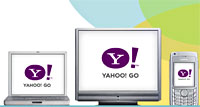 Yahoo is launching a new service aimed at making it easier for users to connect to Yahoo Internet-based services through multiple Web-connected devices, including mobiles and TVs.
Yahoo is launching a new service aimed at making it easier for users to connect to Yahoo Internet-based services through multiple Web-connected devices, including mobiles and TVs.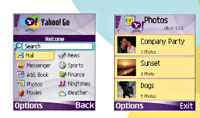 So long as the device is connected to the Internet, users will be able to access their personal Yahoo content such as photos, email and address books.
So long as the device is connected to the Internet, users will be able to access their personal Yahoo content such as photos, email and address books.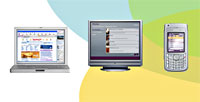 Yahoo! will be rolling out their Go TV service in the next few months, with the service enabling users to access various other Web based services for TVs, including local movie listing search and personalised MyYahoo! functions.
Yahoo! will be rolling out their Go TV service in the next few months, with the service enabling users to access various other Web based services for TVs, including local movie listing search and personalised MyYahoo! functions.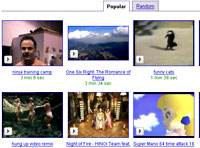 Slapping iTunes around the face with their hefty gauntlet, Google have laid down a challenge to iTunes with the announcement of their new video and television Internet service, the Google Video Store.
Slapping iTunes around the face with their hefty gauntlet, Google have laid down a challenge to iTunes with the announcement of their new video and television Internet service, the Google Video Store. The service promises to “democratise” video sales, letting wannabe Spielbergs sell their movies on Google Video Store, with Google taking what Larry Page has described as a “very low” percentage of the sale cost.
The service promises to “democratise” video sales, letting wannabe Spielbergs sell their movies on Google Video Store, with Google taking what Larry Page has described as a “very low” percentage of the sale cost.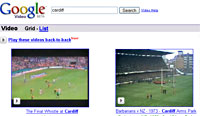 Visitors to the Google Video homepage at
Visitors to the Google Video homepage at 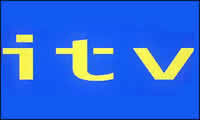 Speculators with a wad of cash might like to consider convert said cash into an ITV plc share holding in the next few days some feel.
Speculators with a wad of cash might like to consider convert said cash into an ITV plc share holding in the next few days some feel. Unlike Sky, which is principally a broadcast platform owner and call centre operator, ITV actually has what companies with desires to be fully-grown media giants badly need; content and a fifty year plus heritage of making TV programmes.
Unlike Sky, which is principally a broadcast platform owner and call centre operator, ITV actually has what companies with desires to be fully-grown media giants badly need; content and a fifty year plus heritage of making TV programmes.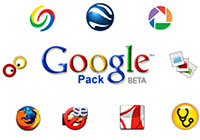 Like a pub drunk wanting to take on the entire world, Google have gone over to Microsoft’s table, knocked over their pints and invited them out for a scrap.
Like a pub drunk wanting to take on the entire world, Google have gone over to Microsoft’s table, knocked over their pints and invited them out for a scrap. Marissa Mayer, VP of search products and user experience at Google commented, “The pack has been created to give users a way to painlessly install all the essential software they need – pre-configured in a sensible way – in a matter of minutes. Better yet, users don’t have to keep track of software updates or new programs – we maintain and update all the software for them.”
Marissa Mayer, VP of search products and user experience at Google commented, “The pack has been created to give users a way to painlessly install all the essential software they need – pre-configured in a sensible way – in a matter of minutes. Better yet, users don’t have to keep track of software updates or new programs – we maintain and update all the software for them.”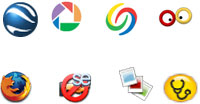 Josh Bernoff, a media and internet analyst at Forrester, a technology research company, described the move as a “direct action to challenge Microsoft,” adding, “Google is saying, ‘We can manage the browser and other elements of the computer-desktop experience better than you’.”
Josh Bernoff, a media and internet analyst at Forrester, a technology research company, described the move as a “direct action to challenge Microsoft,” adding, “Google is saying, ‘We can manage the browser and other elements of the computer-desktop experience better than you’.” Interestingly, after
Interestingly, after  Mr Gates, speaking in the keynote address at the Consumer Electronics Show (CES) in Las Vegas, evangelised the “arrival of the much-trailed ‘digital lifestyle’” (which of course, we here at Digital Lifestyles just loved when
Mr Gates, speaking in the keynote address at the Consumer Electronics Show (CES) in Las Vegas, evangelised the “arrival of the much-trailed ‘digital lifestyle’” (which of course, we here at Digital Lifestyles just loved when 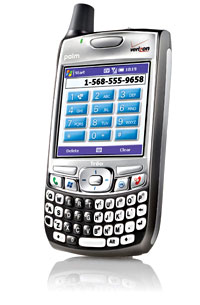 Palm have finally announced the launch of their much anticipated Windows Mobile powered Treo 700w smartphone.
Palm have finally announced the launch of their much anticipated Windows Mobile powered Treo 700w smartphone. The transition to Windows has, however, seen the TFT screen resolution shrink from Palm’s 320 x 320 pixels to a more miserly 240 x 240 pixels (the same as the Treo-alike HP iPAQ hw6500 series). Early reports suggest that the screen is somewhat washed out compared to the current Palm Treo 650.
The transition to Windows has, however, seen the TFT screen resolution shrink from Palm’s 320 x 320 pixels to a more miserly 240 x 240 pixels (the same as the Treo-alike HP iPAQ hw6500 series). Early reports suggest that the screen is somewhat washed out compared to the current Palm Treo 650.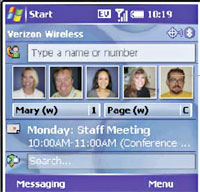 The removable battery gives up to 4.7 hours of talk time or up to 15 days of standby.
The removable battery gives up to 4.7 hours of talk time or up to 15 days of standby.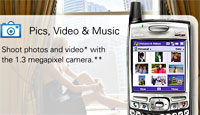 If Palm have successfully managed the transition to the Windows platform, we can expect this new smartphone to be a winner, although we do wonder what long-term impact it may have on their Palm OS range.
If Palm have successfully managed the transition to the Windows platform, we can expect this new smartphone to be a winner, although we do wonder what long-term impact it may have on their Palm OS range. Happy New Year!!Since the New Year has just begun, a piece focusing on last year, the one that has just begun and the developments suspected to emerge during it seemed justified.
Happy New Year!!Since the New Year has just begun, a piece focusing on last year, the one that has just begun and the developments suspected to emerge during it seemed justified.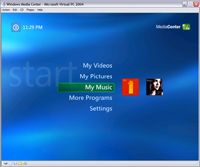 You might wonder why I am so confident in this prediction: Afterall, Microsoft has been pushing out
You might wonder why I am so confident in this prediction: Afterall, Microsoft has been pushing out 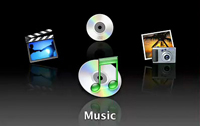 There were of course
There were of course  However, this has always been on quite specific Mac-related Websites, and not in main stream media.
However, this has always been on quite specific Mac-related Websites, and not in main stream media.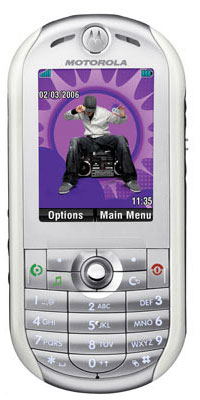 Motorola says adieu to Apple and bonjour to Linux as it unveiled its shiny new ROKR E2 phone at the Consumer Electronics Show today.
Motorola says adieu to Apple and bonjour to Linux as it unveiled its shiny new ROKR E2 phone at the Consumer Electronics Show today.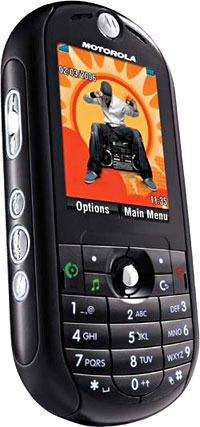 Running on a new Linux-based operating system, the Motorola ROKR E2 also includes a high-res 320×240 screen, a 1.3 megapixel camera with video recording, a built-in FM radio, Opera Web browser Bluetooth (supporting wireless music streaming to stereo Bluetooth headphones), and joy-of-joys – a standard 3.5mm stereo headphone jack and not one of those ruddy annoying mini sockets that are incompatible with normal headphones.
Running on a new Linux-based operating system, the Motorola ROKR E2 also includes a high-res 320×240 screen, a 1.3 megapixel camera with video recording, a built-in FM radio, Opera Web browser Bluetooth (supporting wireless music streaming to stereo Bluetooth headphones), and joy-of-joys – a standard 3.5mm stereo headphone jack and not one of those ruddy annoying mini sockets that are incompatible with normal headphones.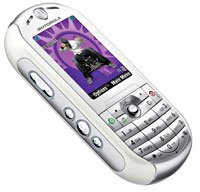 In the absence of iTunes, Motorola intends to push their iRadio Music Service, a subscription music service that uses mobile handsets as the base platform.
In the absence of iTunes, Motorola intends to push their iRadio Music Service, a subscription music service that uses mobile handsets as the base platform. The BBC has announced its Open News Archive, making archive news reports freely available to the UK public to download and use for free in their own creative works.
The BBC has announced its Open News Archive, making archive news reports freely available to the UK public to download and use for free in their own creative works. Made available under the terms of the recently-launched Creative Archive Licence, the footage can be viewed, downloaded, edited and mixed by UK residents – so long as it’s for non-commercial programming (there’s also several other caveats that budding film makers should read first
Made available under the terms of the recently-launched Creative Archive Licence, the footage can be viewed, downloaded, edited and mixed by UK residents – so long as it’s for non-commercial programming (there’s also several other caveats that budding film makers should read first 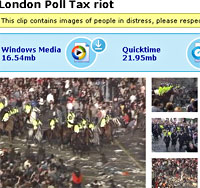 Helen Boaden, Director, BBC News, said: “This trial is an important step in allowing us to share with our audiences the extraordinary news archive which the BBC has recorded over the years. We look forward to getting their reaction.”
Helen Boaden, Director, BBC News, said: “This trial is an important step in allowing us to share with our audiences the extraordinary news archive which the BBC has recorded over the years. We look forward to getting their reaction.” The BBC already offer nearly a hundred clips in their
The BBC already offer nearly a hundred clips in their